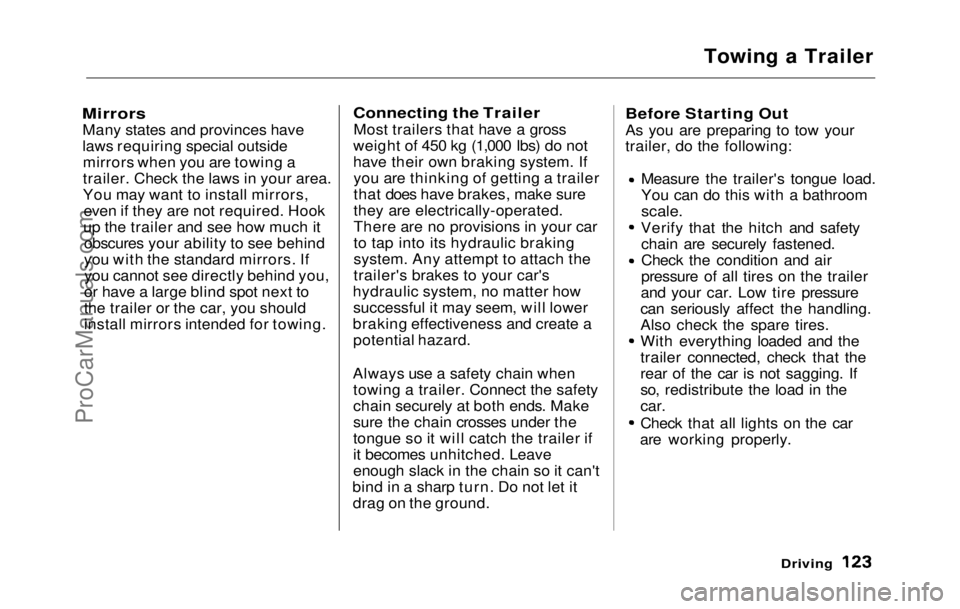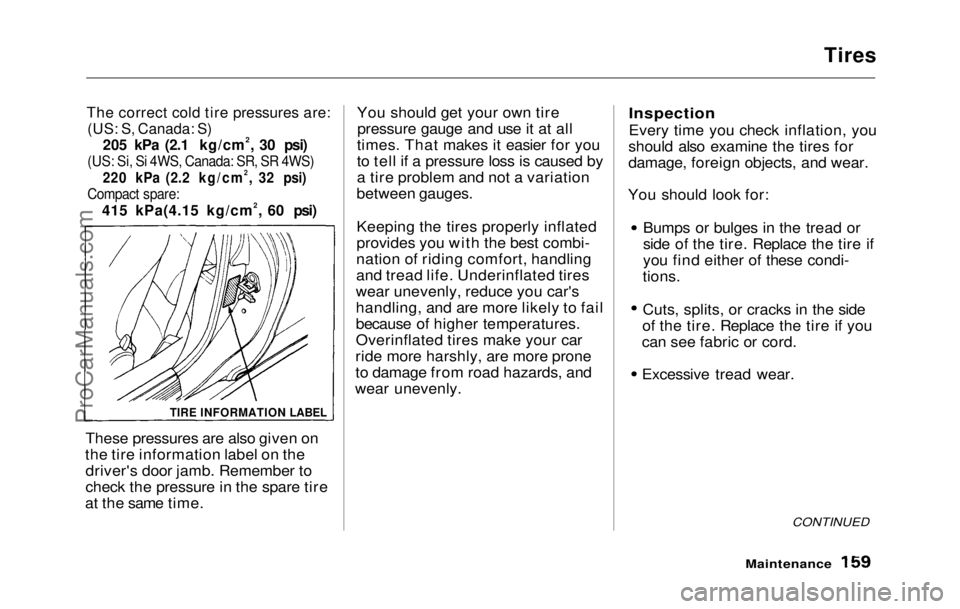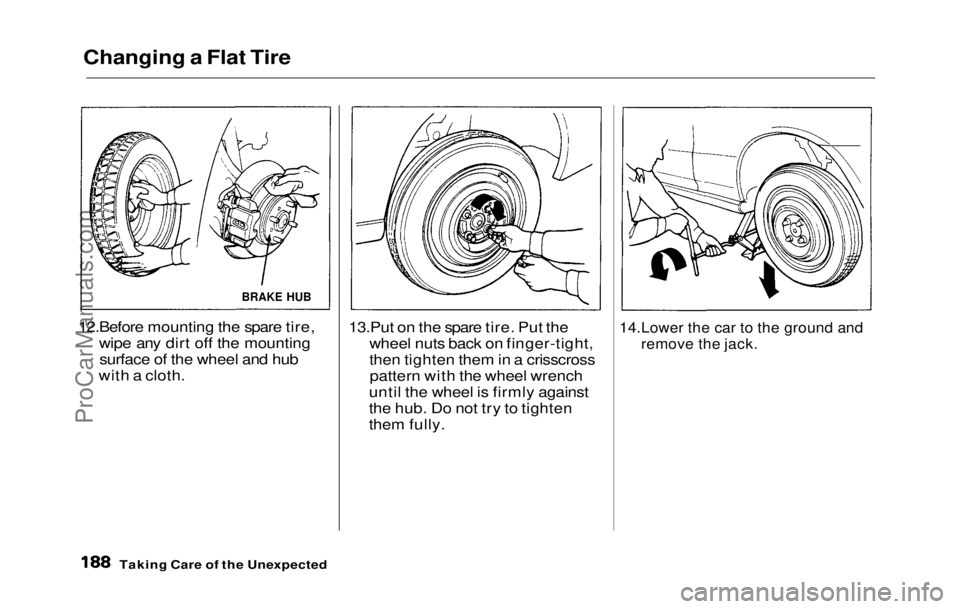1992 HONDA PRELUDE spare tire
[x] Cancel search: spare tirePage 122 of 225

Towing a Trailer
Mirrors
Many states and provinces have
laws requiring special outsidemirrors when you are towing a
trailer. Check the laws in your area.
You may want to install mirrors, even if they are not required. Hook
up the trailer and see how much it obscures your ability to see behind
you with the standard mirrors. Ifyou cannot see directly behind you,
or have a large blind spot next to
the trailer or the car, you should
install mirrors intended for towing.
Connecting the Trailer
Most trailers that have a gross
weight of 450 kg (1,000 Ibs) do not
have their own braking system. If you are thinking of getting a trailer
that does have brakes, make sure
they are electrically-operated.
There are no provisions in your car
to tap into its hydraulic braking
system. Any attempt to attach the
trailer's brakes to your car's
hydraulic system, no matter how successful it may seem, will lower
braking effectiveness and create a potential hazard.
Always use a safety chain when towing a trailer. Connect the safety
chain securely at both ends. Make
sure the chain crosses under the
tongue so it will catch the trailer if
it becomes unhitched. Leave
enough slack in the chain so it can't
bind in a sharp turn. Do not let it drag on the ground.
Before Starting Out
As you are preparing to tow your
trailer, do the following:
Measure the trailer's tongue load.
You can do this with a bathroom
scale.
Verify that the hitch and safety chain are securely fastened.
Check the condition and air
pressure of all tires on the trailer
and your car. Low tire pressure
can seriously affect the handling.
Also check the spare tires.
With everything loaded and the
trailer connected, check that the
rear of the car is not sagging. If
so, redistribute the load in the
car.
Check that all lights on the car
are working properly.
DrivingProCarManuals.comMain Menu Table of Contents s t
Page 157 of 225

Tires
The correct cold tire pressures are:
(US: S, Canada: S)
205 kPa (2.1 kg/cm2, 30 psi)
(US: Si, Si 4WS, Canada: SR, SR 4WS)
220 kPa (2.2 kg/cm2, 32 psi)
Compact spare:
415 kPa(4.15 kg/cm2, 60 psi)
These pressures are also given on
the tire information label on the driver's door jamb. Remember to
check the pressure in the spare tire
at the same time. You should get your own tire
pressure gauge and use it at all
times. That makes it easier for you
to tell if a pressure loss is caused by
a tire problem and not a variation
between gauges.
Keeping the tires properly inflated
provides you with the best combi-
nation of riding comfort, handling
and tread life. Underinflated tires
wear unevenly, reduce you car's
handling, and are more likely to fail
because of higher temperatures.
Overinflated tires make your car
ride more harshly, are more prone
to damage from road hazards, and
wear unevenly.
Inspection
Every time you check inflation, you
should also examine the tires for
damage, foreign objects, and wear.
You should look for:
Bumps or bulges in the tread or
side of the tire. Replace the tire if
you find either of these condi-
tions. Cuts, splits, or cracks in the side
of the tire. Replace the tire if you
can see fabric or cord.
Excessive tread wear.
CONTINUED
Maintenance
TIRE INFORMATION LABELProCarManuals.comMain Menu Table of Contents s t
Page 179 of 225

Taking Care of the Unexpected
This section covers the more- common problems that motorists
experience with their cars. It gives
you information about how to
safely evaluate the problem and
what to do to correct it. If the problem has stranded you on the
side of the road, you may be able to
get going again. If not, you will also
find instructions on getting your
car towed. Compact Spare Tire..................... 184
Changing a Flat Tire................... 185
If Your Engine Won't Start........ 190 Nothing Happens...................... 190
The Starter OperatesNormally................................ 191
Jump Starting................................ 191 If Your Engine Overheats.......... 193
Low Oil Pressure.......................... 195
Charging System Indication ...... 196
Check Engine Light..................... 197
Closing the Sunroof ..................... 198
Fuses............................................... 199 Checking and Replacing.........
200
Towing...........................................
202
Taking Car e
of the UnexpectedProCarManuals.comMain Menu s t
Page 180 of 225

Compact Spare Tire
Your car has a compact spare tire
that takes up less space. Use this
spare tire as a temporary replace-
ment only. Get your regular tire
repaired or replaced and put back
on your car as soon as you can.
Check the inflation of the compact
spare tire every time you check the
other tires. It should be inflated to: 415 kPa (4.15 kg/cm2, 60 psi)
Follow these precautions whenever
you are using the compact spare
tire:
Do not exceed 50 mph (80 km/h)
under any circumstances. This tire gives a harsher ride and
less traction on some road sur-
faces than the regular tire. Use
greater caution while driving on
this tire.
Do not mount snow chains on the
compact spare.
The wheel
of the compact spare
tire is designed especially to fit
your car. Do not use your spare
tire on another car unless it is the
same make and model. The compact spare tire has a
shorter tread life than a regular
tire. Replace it when you can see
the tread wear indicator bars. The
replacement should be the same
size and design tire, mounted on
the same wheel. The compact spare
tire is not designed to be mounted
on a regular wheel, and the com- pact wheel is not designed for
mounting a regular tire.
Taking Care of the Unexpected
INDICATOR
LOCATION
MARK
TREAD WEARINDICATOR
BARProCarManuals.comMain Menu Table of Contents s t
Page 181 of 225

Changing a Flat Tire
If you
have a flat tire while driving,
stop in a safe place to change it.
Stopping in traffic or on the shoul-
der of a busy road is dangerous.
Drive slowly along the shoulder
until you get to an exit or an area to stop that is far away from the traf-
fic lanes.
1. Park the car on firm, level ground away from traffic. Turnon the hazard warning lights and
turn the ignition to LOCK (0). 2. Put the transmission in Park
(automatic) or Reverse (5-speed).
Set the parking brake.
3. Open the trunk. Raise the trunk floor by lifting up on the back
edge.
4. Take the tool kit out of the trunk. 5. Unscrew the wing bolt and take
the spare tire out of the trunk.
Taking Care of the Unexpected
CONTINUED
The car can easily roll off the
jack, seriously injuring anyone
underneath.
Follow the directions for chang-
ing a tire exactly, and never
get under the car when it is
supported only by the jack.
TRUNK FLOOR
JACK
SPARE TIRE
TOOL KITProCarManuals.comMain Menu Table of Contents s t
Page 184 of 225

Changing a Flat Tire
12.Before mounting
the spare tire,
wipe any dirt off the mounting
surface of the wheel and hub
with a cloth.
13.Put on
the spare tire. Put the
wheel nuts back on finger-tight,
then tighten them in a crisscross
pattern with the wheel wrench
until the wheel is firmly against
the hub. Do not try to tighten
them fully.
14.Lower th e
car to the ground and
remove the jack.
Taking Car
e
of the Unexpected
BRAKE HUBProCarManuals.comMain Menu Table of Contents s t
Page 218 of 225

Index
Brightness Control, Instruments................................. 41
Brights, Headlights........................ 40
Bulb Replacement Back-up Lights......................... 169
Brake Lights.............................
169
Front Parking
Lights ..............
165
Front Side
Marker Lights......
166
Headlights................................. 164
High-mount Brake
Light........
168
License Plate
Lights................
171
Rear Sid
e
Marker Lights........
170
Specifications............................ 207
Turn Signa
l
Lights ..................
167
Bulbs, Halogen.............................
.
164
Cables, Jum
p
Starting With........
191
Capacities Chart...........................
206
Carbo
n Monoxide Hazard ............ 25
Cargo, Loading.............................
106
Cassette Playe r
Care..............................................
. 94
Operation.............................. 81,
91
Catalytic Converter.................... .
213
CAUTION, Explanatio
n
of............ ii
Center Console Compartment..... 64
Certification Label....................... 204
Chains............................................. 163
Change Oil
How to........................................ 137
When to...................................... 129
Changing a Flat Tire................... 185
Changing Engine Coolant........... 140
Charging System Light........ 33, 196
Check Engine Light............. 34, 197
Checking
Automatic Transmission
Fluid........................................
144
Battery Condition.................... .
152
Brake Flui
d
...............................
146
Clutch Fluid.............................
.
147
Engine Belts.............................
.
158
Engine Oil.................................
.
135
Fuses........................................... 199
Manual Transmissio
n
Fluid...
145
Power Steerin
g
Fluid..............
148
Radiator Coolant.....................
.
139
Checklist, Befor
e
Driving...........
108
Child Safety....................................
.
18
Cigarette Lighter........................... 65
Cleaner, Air...................................
149
Cleaning
Exterior......................................
176
Interior....................................... 179
Seat Belts...................................
179
Vinyl........................................... 179
CLEAN Light................................
.
94
Clock, Setting the.......................... 63
Clutch Fluid..................................
147
CO i n
the Exhaust........................
211
Cold Weather
,
Starting in...........
110
Compact Spare.............................
.
184
Consumer Information................
217
Controls, Instruments
and............ 29
Coolant
Adding........................................ 139
Checking.................................... 139
Proper Solution......................... 139
Temperature Gauge.................. 38
Corrosion Protection................... 180
Crankcase Emission Control
System........................................ 211
Cruise Control Operation ............. 44
Customer Relations Office......... 217ProCarManuals.comMain Menu s t
Page 223 of 225

Index
Reminder Light and Beeper..... 33
Replacement.................................. 9
System Components.................... 6
Tether Attachment Points....... 21
Use During Pregnancy................ 8
Wearing a Lap/Shoulder Belt.... 7
Seats, Adjusting the....................... 51
Serial Number............................... 204
Service Intervals..........................
129
Service Manual............................
.
221
Service Station Procedures........ 100
Setting th
e
Clock............................ 63
Shifting The Automatic Transmission
..................................................
112
The 5- Speed
Transmission.....
111
Shift Leve
r
Position
Indicator...............................
36, 112
Side Marke r
Lights, Bulb
Replacement in.........................
166
Signaling Turns............................. .
41
Snow Tires.....................................
163
Solvent-type Cleaners................ .
176
Sound Syste
m
................................. 75
Spare Tire
Inflating .....................................
184
Specifications............................ 207
Spar
k Plugs, Replacing............... 150
Specifications Charts.................. 206
Speed Control.................................. 44
Speedometer.................................... 37
SRS Indicator........................... .
14, 34
START (Ignition Key Position)..
47
Starting th e
Engine......................
109
In Col
d
Weather
at High Altitude....................
110
With a Dea
d Battery................
191
Steam Comin
g
from Engine.......
193
Steering Whee
l
Adjustment.................................
. 43
Anti-theft Column Lock........... 47
Stereo Sound System..................... 75
Storing Your Car..........................
173
Sunroof............................................. 58
Closin
g Manually.....................
198
Operation.....................................
58
Supplementa
l Restraint System
Service Precautions................... 15
Servicing...................................... 14
SRS Indicator........................ 14, 34
System Components.................. 10
Technical Description............ .
209
Tachometer.....................................
37
Taillights
, Changing Bulbs in.... 169
Taking Care of the
Unexpected ...............................
183
Tape Player.................................... .
81
Technical Descriptions Anti-lock Brake System ......... 208Catalytic Converter................. 213
Emission Control Systems......
211
Four Whee l
Steering ............... 210
Supplemental Restraint
System....................................
209
Temperature Gauge..................... .
38
Tether Attachment Points...........
21
Time, Settin g
the ........................... 63
Tire Chains.................................... 163
Tire, How to Change a Flat........ 185
Tires................................................ 158
Air Pressure.............................. 158Checking Wear......................... 159
Compact Spare.......................... 184
DOT Tire Quality Grading..... 161
CONTINUEDProCarManuals.comMain Menu s t